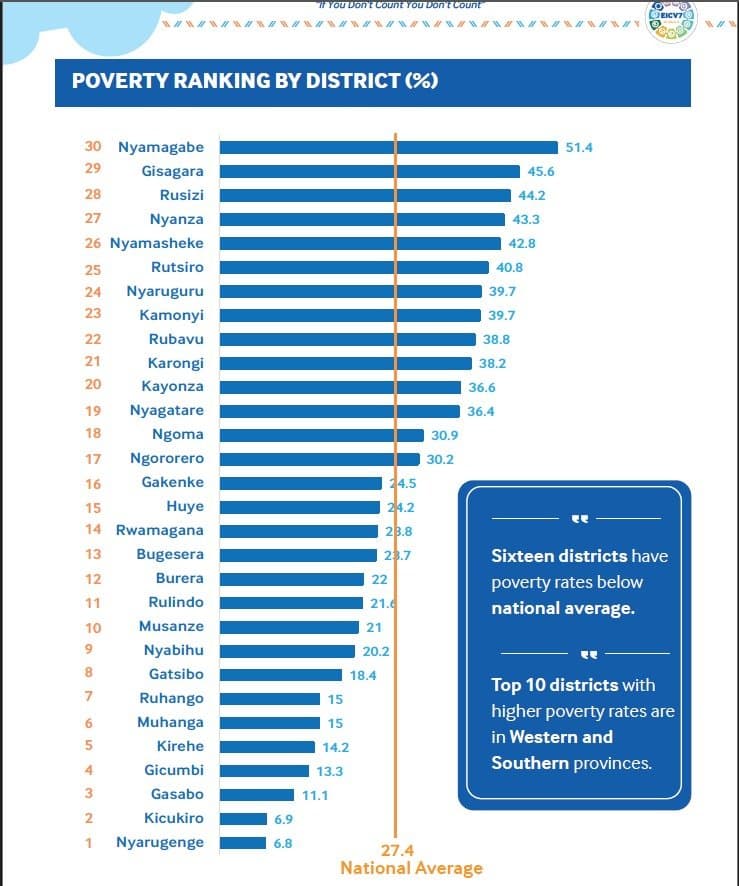According to the latest findings from the 7th Integrated Household Living Conditions Survey (EICV7), Rwanda has made significant strides in reducing poverty. The national poverty rate dropped from 39.8% in 2017 to 27.4% in 2024, while extreme poverty fell sharply from 11.3% to 5.4% over the same period. However, the data reveals stark contrasts between the country’s richest and poorest districts, highlighting ongoing regional inequalities.
Poorest districts struggle despite national progress
The survey ranks Nyamagabe as the district with the highest poverty rate at 51.4%, followed by Gisagara (45.6%), Rusizi (44.2%), Nyanza (43.3%), and Nyamasheke (42.8%). All ten districts with the highest poverty levels are located in the Western and Southern Provinces, indicating persistent economic challenges in rural regions.
Top 5 Poorest Districts:
- Nyamagabe – 51.4%
- Gisagara – 45.6%
- Rusizi – 44.2%
- Nyanza – 43.3%
- Nyamasheke – 42.8%
The rural poverty rate now stands at 31.6%, while urban areas report a significantly lower rate of 16.7%. The Western Province remains the most affected, while the City of Kigali reports the lowest poverty levels. Only 14 districts had more than 40% of their population living in poverty in 2024, down from 22 districts in 2017. Meanwhile, 16 districts now report poverty rates below the national average.
Among the districts, Musanze recorded the most dramatic improvement, with poverty levels falling from 42.3% to 21.0%—a 21.3 percentage-point drop.
Leadership highlights long-term impact of strategic planning
Prime Minister Dr. NGIRENTE stated that the moment is not just about presenting a report, but a reflection on how far Rwanda has come, a recognition of the milestones achieved, and a reaffirmation of the shared commitment to a brighter future. He highlighted that one of the key findings observed is the strong correlation between the increase in household consumption and economic growth. Families are now able to afford better nutrition, improved healthcare, quality education for their children, and an overall higher standard of living.
“These achievements were realised over the seven years of implementing the first National Strategy for Transformation (NST1),” said Prime Minister Ngirente. “They were driven mainly by strategic investments made by the Government of Rwanda and its partners over the last seven years.”
He added: “The long-standing social protection schemes played an important role in improving the well-being of our citizens. These efforts have also effectively contributed to the creation of income-generating activities and job opportunities in Rwanda, and it is a clear demonstration of the impact that can be achieved through good planning and effective implementation.”
Richest districts set benchmark for prosperity
Urban districts dominate the list of Rwanda’s least impoverished areas. Nyarugenge and Kicukiro, both in Kigali, boast the lowest poverty rates at 6.8% and 6.9%, respectively. Gasabo, another Kigali district, follows at 11.1%, while Gicumbi and Kirehe also fall among the top five richest districts.
Top 5 Richest Districts:
- Nyarugenge – 6.8%
- Kicukiro – 6.9%
- Gasabo – 11.1%
- Gicumbi – 13.3%
- Kirehe – 14.2%
The disparity between urban and rural districts reflects broader trends in economic development, with cities benefiting from better infrastructure, education, and employment opportunities.

Key Indicators and Economic Outlook
The Director General of NISR, Ivan Murenzi, presented the key findings of the survey, stating that poverty in Rwanda has decreased substantially over the past seven years. The national extreme poverty rate now stands at 3.1%, marking a 5.9 percentage-point drop from 2017.
According to Murenzi, a Rwandan needs at least 560,027 Rwandan Francs annually to meet the basic cost of food and non-food necessities.
The report also highlighted improvements in several socio-economic indicators, particularly in rural areas. Access to electricity rose from 34.4% to 72%, mobile phone ownership increased from 66.9% to 84.6%, and internet access grew from 17% to 30%. Access to improved drinking water sources also significantly increased, boosting rural well-being and quality of life.
Forward-Looking Policy Direction
Minister of Finance and Economic Planning, Yusuf Murangwa, described the release of the report as timely. He emphasized that it will support evidence-based policymaking to achieve the goals of the Second National Strategy for Transformation (NST2).
“These results will define where and how the government and partners should invest to get maximum results for NST2 objectives by 2029,” he said.





